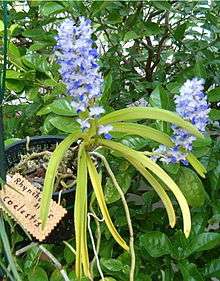Rhynchostylis
| Rhynchostylis | |
|---|---|
 | |
| Rhynchostylis coelestis | |
| Scientific classification | |
| Kingdom: | Plantae |
| (unranked): | Angiosperms |
| (unranked): | Monocots |
| Order: | Asparagales |
| Family: | Orchidaceae |
| Subfamily: | Epidendroideae |
| Tribe: | Vandeae |
| Subtribe: | Aeridinae |
| Alliance: | Phalaenopsis |
| Genus: | Rhynchostylis Blume |
| Type species | |
| Rhynchostylis retusa (Sw.) Blume. | |
| Synonyms[1] | |
|
Anota Schltr. | |
Rhynchostylis (abbreviated Rhy in the horticultural trade) is a genus in the Orchid family (Orchidaceae),closely allied to the genus Vanda (from which it differs in the one-lobed lip of the flower) and comprising four currently accepted species native to the Indian Subcontinent, China, Indochina, Malaysia, Indonesia and the Philippines.[1][2] The name consists of a compound of two Greek elements : rhynchos 'beak' and stylis 'column' - in reference to the very boad, fleshy column of the flower. The flowers are borne in dense racemes and are noted for their intense, spicy fragrance. Although lacking in pseudobulbs, the plants have leathery leaves that are drought-resistant. These orchids grow naturally in warm, moist, shaded tropical areas and will thrive in cultivation if given consistent warmth, uniform moisture and bright, but indirect light. Hobbyists wanting to grow them will need a warm, humid growing environment with gentle air movement. They can be grown in pots, but are better grown in baskets, owing to the extreme fleshiness of their roots. Their unusually fragrant blooms often appear in the slightly cooler Winter months.[3]
Despite being in the Vanda Tribe, they are very different from Vandas. They grow more slowly, their roots are more fragile, and almost any direct sun will harm them. However, they are typically grown with no potting mix on slat baskets or mounted in the same way as Vandas.[4] [5]
The genus possesses valuable medicinal properties meriting in-depth pharmacological investigation, including antispasmodic and antiseptic activity.[6] Several species have been found to contain alkaloids.[7]
The Subtribe was changed from Sarcanthinae (Benth, 1881) to Aeridinae (Pfitzer, 1887) in 1972.[8][9]
Species
As of February 2016, four species are recognized though many others have been proposed:[1]
- Rhynchostylis coelestis (Rchb.f.) A.H.Kent in H.J.Veitch - Cambodia, Thailand, Vietnam
- Rhynchostylis gigantea (Lindl.) Ridl. - widespread in Hainan, Andaman Islands, Myanmar, Thailand, Vietnam, Laos, Cambodia, Malaysia, Borneo, Philippines
- Rhynchostylis gigantea subsp. gigantea - all of species range except Philippines
- Rhynchostylis gigantea subsp. violacea (Lindl.) Christenson - Philippines
- Rhynchostylis retusa (L.) Blume - Yunnan, Guizhou, India, Sri Lanka, Nepal, Bhutan, Assam, Bangladesh, Andaman & Nicobar Islands, Indochina, Malaysia, Borneo, Sumatra, Java, Philippines
- Rhynchostylis rieferi (Higgins) - Philippines
References
- 1 2 3 Kew World Checklist of Selected Plant Families
- ↑ Flora of China v 25 p 474, 钻喙兰属 zuan hui lan shu, Rhynchostylis Blume
- ↑ The Illustrated Encyclopedia of Orchids ed. Pridgeon,Alec,pub. Lansdowne Publishing Pty Ltd. Australia 1992 and David and Charles UK 2003.ISBN 0 7153 1782 2
- ↑ "AOS Sheet on Rhynchostylis Gigantea".
- ↑ "Jay's IOSPE on Rhynchostylis".
- ↑ Orchid Biology: Reviews and Perspectives, III ed. Arditti,Joseph,pub.Comstock Publishing Associates - a division of Cornell University Press 1984 ISBN 0-8014-1040-1 (v.1) : Chapter 2 : Ethnobotany of the Orchidaceae by Lawler,Leonard J. page 101
- ↑ Genera Orchidacearum: Epidendroideae edited by Alec M. Pridgeon, Phillip J. Cribb, Finn N. Rasmussen, Mark W. Chase
- ↑ Vandeae
- ↑ "Molecular phylogenetics of Vandeae (Orchidaceae) and the evolution of leaflessness".
External links
 Media related to Rhynchostylis at Wikimedia Commons
Media related to Rhynchostylis at Wikimedia Commons Data related to Rhynchostylis at Wikispecies
Data related to Rhynchostylis at Wikispecies